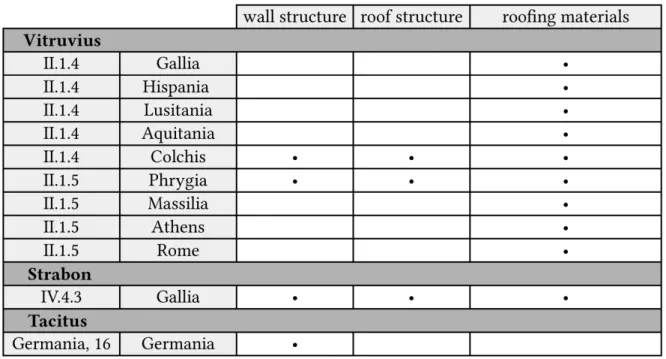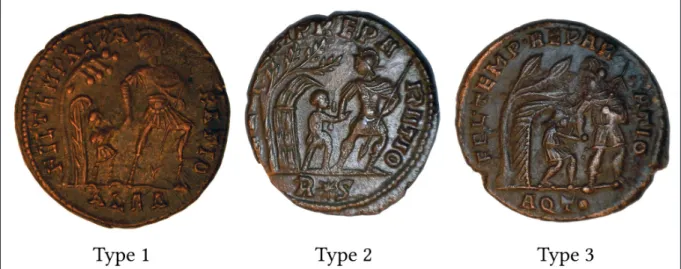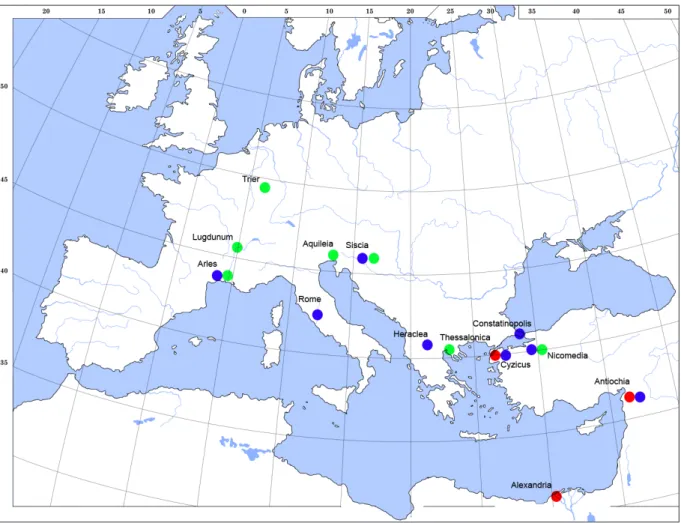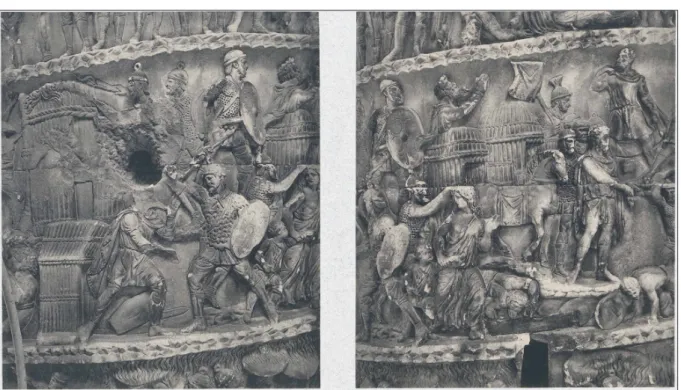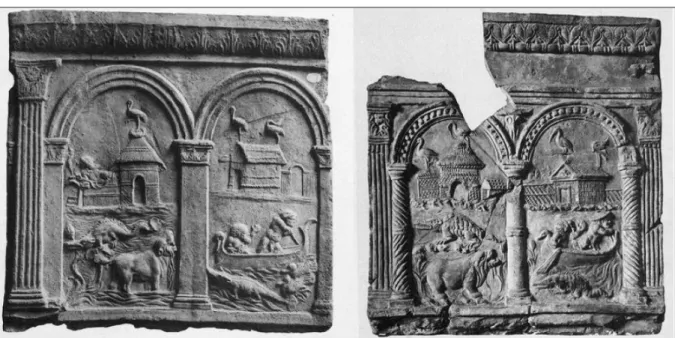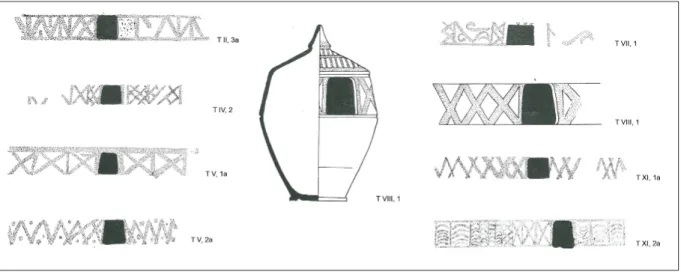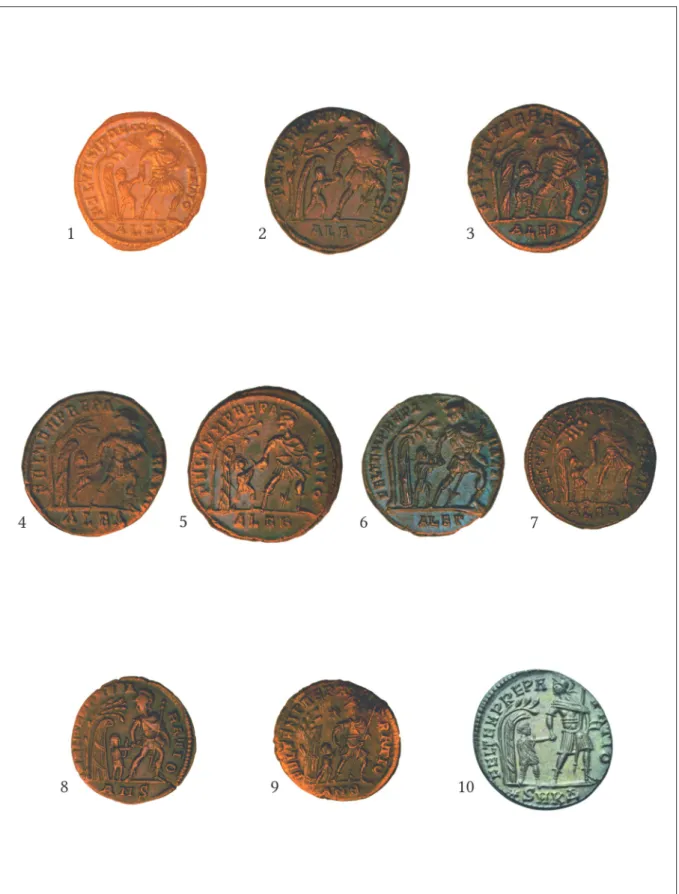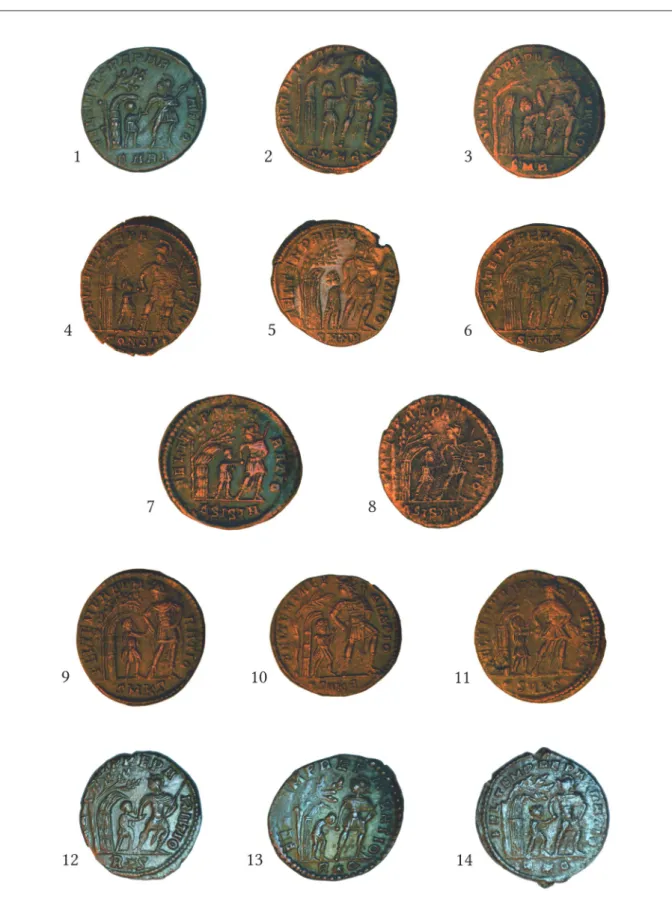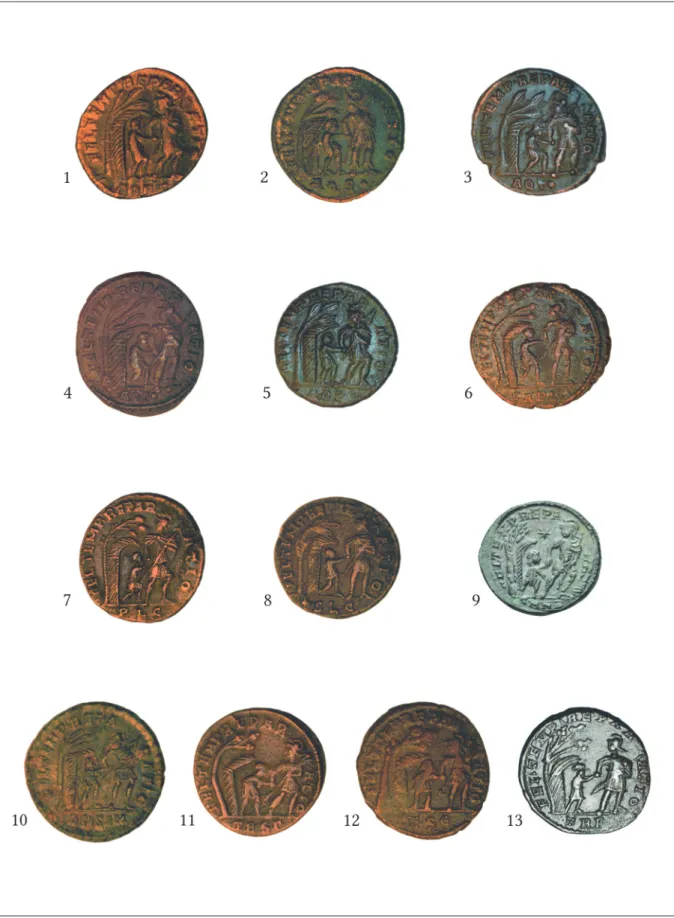Dissertationes Archaeologicae
ex Instituto Archaeologico
Universitatis de Rolando Eötvös nominatae Ser. 3. No. 3.
Budapest 2015
Dissertationes Archaeologicae ex Instituto Archaeologico Universitatis de Rolando Eötvös nominatae
Ser. 3. No. 3.
Editor-in-chief:
Dávid Bartus Editorial board:
László Bartosiewicz László Borhy Zoltán Czajlik
István Feld Gábor Kalla
Pál Raczky Miklós Szabó Tivadar Vida Technical editors:
Dávid Bartus Gábor Váczi Dániel Szabó
Proofreading:
Szilvia Szöllősi Zsófia Kondé
Available online at http://dissarch.elte.hu Contact: dissarch@btk.elte.hu
© Eötvös Loránd University, Institute of Archaeological Sciences
Budapest 2015
Contents
Zoltán Czajlik 7
René Goguey (1921 – 2015). Pionnier de l’archéologie aérienne en France et en Hongrie
Articles
Péter Mali 9
Tumulus Period settlement of Hosszúhetény-Ormánd
Gábor Ilon 27
Cemetery of the late Tumulus – early Urnfield period at Balatonfűzfő, Hungary
Zoltán Czajlik – Balázs Holl 59
Zur topographische Forschung der Hügelgräberfelder in Ungarn
Zsolt Mráv – István A. Vida – József Géza Kiss 71
Constitution for the auxiliary units of an uncertain province issued 2 July (?) 133 on a new military diploma
Lajos Juhász 77
Bronze head with Suebian nodus from Aquincum
Kata Dévai 83
The secondary glass workshop in the civil town of Brigetio
Bence Simon 105
Roman settlement pattern and LCP modelling in ancient North-Eastern Pannonia (Hungary)
Bence Vágvölgyi 127
Quantitative and GIS-based archaeological analysis of the Late Roman rural settlement of Ács-Kovács-rétek
Lőrinc Timár 191
Barbarico more testudinata. The Roman image of Barbarian houses
Field reports
Zsolt Mester – Norbert Faragó – Attila Király 203
Report on the excavation at Páli-Dombok in 2015
Ágnes Király – Krisztián Tóth 213
Preliminary Report on the Middle Neolithic Well from Sajószentpéter (North-Eastern Hungary)
András Füzesi – Dávid Bartus – Kristóf Fülöp – Lajos Juhász – László Rupnik –
Zsuzsanna Siklósi – Gábor V. Szabó – Márton Szilágyi – Gábor Váczi 223 Preliminary report on the field surveys and excavations in the vicinity of Berettyóújfalu
Márton Szilágyi 241
Test excavations in the vicinity of Cserkeszőlő (Jász-Nagykun-Szolnok County, Hungary)
Dávid Bartus – László Borhy – Emese Számadó 245
Short report on the excavations in Brigetio in 2015
Dóra Hegyi 263
Short report on the excavations in the Castle of Sátoraljaújhely in 2015
Maxim Mordovin 269
New results of the excavations at the Saint James’ Pauline friary and at the Castle Čabraď
Thesis abstracts
Krisztina Hoppál 285
Contextualizing the comparative perceptions of Rome and China through written sources and archaeological data
Lajos Juhász 303
The iconography of the Roman province personifications and their role in the imperial propaganda
László Rupnik 309
Roman Age iron tools from Pannonia
Szabolcs Rosta 317
History of the settlement of the Sand Ridges of Kiskunság between the 13th–16th century
Barbarico more testudinata
The Roman image of Barbarian houses
Lőrinc Timár
MTA–ELTE Research Group for Interdisciplinary Archaeology timar.lor@gmail.com
Abstract
There are only few Antique literary sources on simple buildings and depictions which show huts or Barbarian houses are scarce too. The short study makes an attempt to identify structural details that were shown on Late Roman coins and link them to other surviving images.
One of the common problems in Roman and Iron Age archaeology is the interpretation of the remains of simple buildings. When the monumental creations of the Antiquity, masonry buildings and complex cities, were erected by the Romans the earlier buildings of the indigenous population did not vanish on the countryside. Small huts built of perishable materials coexisted with theopera magnaand sometimes they were even mentioned by ancient authors and shown on depictions. Unfortunately, the archaeological vestiges of these simple buildings are not easy to understand because their building materials had decomposed many centuries ago and only the negative imprints of those had remained.1 Thus, the ancient sources seem to be extremely valuable even though they are scarce and it is difficult to assess how useful they are.
The most complete literary references come from three authors: Vitruvius, Strabon and Tacitus.
Fig. 1.shows which structural details were specified by them. We have to remark that roofing materials were almost always mentioned, and there is a note in the text of Vitruvius that those houses were“barbarico more testudinata” (Vitruvius,De architecturaII.14) indicating that the way of roofing should have been a decisive feature of indigenous buildings.
Some other sources show a similar opinion. It has been profoundly analyzed that the pictorial program of the Column of Trajan is evidently juxtaposes Roman and Barbarian buildings and shows the Dacian conquest in a manner that suggests a war of civilizations.2It is hard to regard the pictorial contrast between Dacian and Roman buildings (and Germanic as in the case of the Column of Marcus) another way than the expression of Roman technological superiority. An expressive remark from Tacitus concerning the Frisian’s visit in Rome (Tacitus,Annales13, 54) explains that Barbarians did not understand the achievements of the Roman civilization but the grandeur of its buildings. Recent studies have revealed that the spread of the Roman building materials, notablytegulaeandimbricesfor roofing, had long preceded Romanization in Southern
1 For further details see: Timár 2010; 2011.
2 On the visualization of the Roman conquest and the consequent Romanization: Wolfram Thill 2010, 39;
2011, 308.
DissArch Ser. 3. No. 3 (2015) 191–202. DOI: 10.17204/dissarch.2015.191
Lőrinc Timár
Gaul as the indigenous elite began to adopt the technical achievements of Mediterranian architecture.3This corroborates perfectly with the remark of Vitruvius mentioned above.
Fig. 1.Structural details of indigenous houses.
But how could we utilize our ancient sources? Are the surviving depictions and descriptions really reliable? How many building types existed and which were the differences between the architectures of the indigenous or Barbarian nations? How did Romanization change the architecture of the simple buildings? Is it possible at all to find a link between excavated structures and a ancient sources? There is an endless row of such questions and we are trying to find answers to some of them in the present paper.
The architectural contrast between Roman and Barbarian seems to be repeatedly exploited in imperial propaganda. Beyond the record of Tacitus and the images on the Columns of Marcus and Trajan, there is a series of depictions on the reverse of some Late Roman coins showing a soldier or emperror leading a small captive or Barbarian from a hut located beneath a tree. These coins of the denominationmaiorinaor ’small AE2’4bearing the images of Constans and Constantius II, have the text FEL TEMP REPARATIO on their reverse and they were issued in various mints.5 Although their similarity suggests that there was an official blueprint issued for the coin dies, one can observe significant differences in the execution of the hut’s image. There are also several species of trees on the different variants and it has been already noted that the coins issued in Antiochia show a conifer tree while coins from the Western Provinces show broadleaf trees6. It has to be mentioned here that these trees are depicted with an emphasis on the tree’s individual leafs instead of the whole crown which was a development of Roman art and very well visible on the Column of Trajan.7
3 Clement 2011, 84. On general questions see Desbat 2003, 124–128.
4 See RIC VIII, 34.
5 RIC VIII lists 13 mints: Trier (p. 153), Lyons (p.182), Arles (p. 219), Rome (p. 258), Aquileia (p. 323), Siscia (p. 365), Thessalonica (p. 412), Heraclea (p. 434), Constantinople (p. 453), Nicomedia (p. 475), Cyzicus (p. 495), Antiochia (p.
522), Alexandria (p. 542).
6 Weiser 1987, 165–166.
7 Lehmann-Hartleben 1926, 135.
192
Barbarico more testudinata.The Roman image of Barbarian houses
In the collection of the Hungarian National Museum’s Department for Coins and Medals, coins from twelve mints are represented.8Three hut types could be observed(Fig. 2)on the 35 coins which were chosen for evaluation.
Fig. 2.Principal hut types. Type 1 wall with twisted ribbon (Alexandria, ÉT. Weszerle 276); Type 2 wall made of stick bundles (Rome, ÉT. 54.1951.1049); Type 3 wall depicted with slant stripes (Aquileia, ÉT.
64.1867.2).
The first hut type’s wall(Fig. 8)is depicted with curved vertical lines suggesting bundles kept together by a diagonally twisted ribbon. The second type’s wall(Fig. 9)is shown as a number of vertical lines referring to bundles with one or more horizontal ribbons. If there is only one ribbon it divides then wall portion from the roof. The third type’s wall(Fig. 10)is filled with slant stripes. Although these details are far from being precise and they appear to be very abstract, their primary significance to us is their geographical distribution.Fig. 3.shows which types were observed on the coins studied. We have to remark that this list should be regarded as incomplete because it is based on one a relatively small sample and it is possible that other types were struck in some of these towns too9as in the case of Nicomedia and Cyzicus.10 Type 3 walls are almost uniform, but Type 1 and Type 2 hut walls vary in execution. There are differences in the direction and the number of turns of the ribbon for the first type, and Type 2 walls are sometimes shown with dashed lines suggesting an uneven texture (e. g. on coins from Arles and Siscia, seeFig. 9).
A detailed analysis of this coin revealed the depiction’s historical background. All four coin types11 bearing the inscription FEL(icium) TEMP(orum) REPARATIO are to be associated with military campaigns of Constans and Constantius II, and the scene with the hut and the Barbarian presumably refers to the capture or relocation of the Franks by Constans12. The obverse of the
8 Special thanks are due to curator István Vida for his kind help.
9 E. g. an example from Trier with Type 3 wall was listed on an auction site (http://www.poinsignon-numisma- tique.fr/monnaies_r5/empire-romain_c11/crispe-a-honorius-317-a-395_p110/constance-ii-337-361-maiorina- treves-1ere-officine-348-350-r-soldat-casque-a-droite_article_87620.html).
10 Coins with Type 3 huts from Nicomedia and Type 1 huts from Cyzicus were listed at an auction (www.gitbud- naumann.de, Auktion 18 of 2014, lots 931 and 933, see http://www.acsearch.info/search.html?id=2008901 and http://www.acsearch.info/search.html?id=2008903).
11 Weiser 1987, 161.
12 Weiser 1987, 167–170, see also Tybout 1980.
193
Lőrinc Timár
coins does not seem to be significant at the present stage of the research because both rulers appear on coins with the same hut types.
Fig. 3.Hut types on coins. 1 – twisted ribbon, 2 – bundles; 3 – slant stripes.
The geographical distribution of the hut types(Fig. 4)shows us that the production of coins with Type 1 hut walls was presumably restricted to Cyzicus, Antiochia and Alexandria. We do not know if these three mints formed a distinct group but we have to remark that all the other workshops seem to have produced Types 2 and 3 only. There is no apparent geographical division that would comply with the territories of the Caesars. A more detailed study seems to be unevitable for finding out if there was a mint, presumably in Cyzicus and Nicomedia, where all the three types were manufactured.
These huts have no direct parallels in Roman art. There are three distinct groups of huts that appear in Roman imagery: Barbarian huts of the western part of the Empire, African huts on Northern African mosaics and the dwellings in the Nilotic scenes. We should not overlook the problem that these depictions originate from a very broad time period and a context ranging from the Imperial relief sculpture to the lowest levels of Roman artisanship.
Since these informations are very scattered we have to be cautious concerning the conclusions which could be drawn from them.
Barbarian houses in Roman relief sculpture, notably Dacian and Germanic, are characterized by walls and roofs made of organic materials. It was already noted that the simplicity of them was perhaps intentional.13 The buildings have a rectangular floor-plan on the Column of Trajan14 and their walls are made of horizontal planks with rectangular openings. On the Column of Marcus one can observe huts with walls made of vertical bundles or planks, arched openings
13 Wolfram-Thill, 300–303.
14 See Lehmann-Hartleben 1926, 137 for more commentaires.
194
Barbarico more testudinata.The Roman image of Barbarian houses
(scenes VII, VIII15 and XXI16) or rectangular doors (scene XX, see below). These hut types have an emphasized patterned band where roof and wall join together and this band is not interrupted by the door’s opening. Contrary to this, the depictions on the coins show an arched doorway that protrudes into the roof section. We do not know whether it was modelled after any sort of real building (perhaps a sunked-featured building with a low profile) or it was simply for reducing the hut’s overall height in order to make the image more compact.
Fig. 4.The geographical distribution of the three types. Type 1 – red; Type 2 – blue; Type 3 – green.
There is one remarkable scene on the Column of Marcus. In the lower left field of scene XX17there is hut shown in perspective with a barbarian who is being slaughtered by a Roman soldier(Fig. 5). The hut with the figure standing in front of it definitely has some resemblance to the depictions on the coins. The hut’s walls seem to be identical with the Type 2 hut walls, especially the rendering of the roof with slant lines that indicate perspective shortening. The other huts in scene XX have domed roofs which have all the same texture. The figures are standing in the foreground and appear to be higher than the hut in the background, similar to the image on the coins.
A significant part of the surviving hut depictions are related to the African provinces and the Hellenistic world. Although these scenes can not be described otherwise as pure genre, there are some architectural details that are shown consistently.
15 Petersen 1896, Taf. 14.
16 Petersen 1986, Taf. 28.
17 Petersen 1896, Taf. 27.
195
Lőrinc Timár
Fig. 5.Battle scene from the Column of Marcus, panel XX. Note the hut in the lower left corner (after Petersen 1896, Taf. 27).
The mosaic of Dominus Julius from Carthage shows a doghouse in its upper right corner.18 The walls of the doghouse are wowen and its overall appearance is very similar to the slant stripes seen on coins with Type 3 hut walls. A mosaics from Uzalis (El Alia) exhibits huts with tipped roofs,19various roof and wall patterns and arched doorways. There are horizontal bands on the huts resembling to the Type 2 hut wall pattern on coins.
Nilotic scenes were widespread in Roman art and they were profoundly studied in the past which makes their interpretation less difficult. It is generally accepted that they are more or less allusive copies and reinterpretations of Hellenistic originals20 without any regard to their original meaning.21It is also supposed that pattern books or illustrated guide books were used for rendering the Nilotic landscapes, especially the one from Palestrina,22which makes them more interesting for us, because coins dies seem to have been modelled the same way. The most detailed of them is the Palestrina mosaic, that shows three different types of huts.23Without going into the very details, we have to remark that all of these building types appear in other depictions.24 For we have the same buildings types shown on different media and with various grades of artistic execution, it is possible to compare them in order to assess how realistic or reliable they are. The most undemanding examples are the bone tesserae that show a similar domed building as panel 15 of Palestrina. Contrary to the elaborate details of the mosaic, the walls of the domed hut on the tesserae of the Eurylochou type have a simplified reticulate-like texture.25
18 Dunbabin 1999, 120 fig. 122.
19 Versluys 2002 ,178–181; Foucher 1965, figs. 4 and 9.
20 Meyboom 1996, 103.
21 Meyboom 1996, 84–88.
22 Alföldi-Rosenbaum 1976, 227.
23 Panels 10, 15 and 17. Meyboom 1999, 30.
24 Meyboom 1999, 30; see the respective footnotes.
25 Alföldi-Rosenbaum 1976, 215–216.
196
Barbarico more testudinata.The Roman image of Barbarian houses
Fig. 6.Campana reliefs with Nilotic scenes (after Rohden – Winnefeld 1911, Taf. CXL (Copenhagen) and XXVII (Rome)).
Similar abstraction can be observed on the so-called Campana reliefs dealing with Nilotic scenes. The manufacturing of the Campana reliefs of this type ceased in the 2nd century AD.26 The subject and the arrangement on the plates inFig. 6.is the same, but among other details the wall textures on the houses are different. Although the round houses on the left have similar reticulate-textured walls, the rectangular buildings with gable roof on the right show totally different building materials: one has reed walls and the other is appears to be made ofopus quadratum. This clearly indicates that the structural details were deliberately altered, perhaps consistently, but they can not be regarded as precise images of vernacular buildings from a given geographical region. As far as we know when these reliefs were manufactured, many parts of the composition (especially the figural ones) were stamped.27 It has been also debated if these buildings represent contemporary Egyptian houses at all and it has been suggested that they are only commonplace depictions of non-Roman houses.28 What is interesting in this case it is the transformation of the non-Roman house with organic roof and reed walls to a building made of typical Roman materials.
It would be a convenient explanation that when these reliefs were manufactured the artisans retained the composition of the sample image and did their best to portray exotic beasts and people according to the conventions of Hellenistic genre but the textures, and perhaps the construction details they had applied, came from their own observations made presumably on the local countryside.
As we have seen above in this short overview on a special type of ancient depictions, the image of houses covered with perishable materials had only one meaning in Roman art: those were the buildings of the indigenous and the Barbarians. In the imperial imagery they were even
26 Rauch 1999, 232.
27 Rauch 1999, 241–242.
28 Rauch 1999, 227. It has been also implied that the houses on the Column of Trajan were modelled in the same manner as the Nilotic scenes: Lehmann-Hartleben 1926, 137.
197
Lőrinc Timár
associated with the underlying enemy. The coins with hut depictions clearly show us that the Roman perception of Barbarian houses did not change in the centuries between Vitruvius and Constans.
Fig. 7.House-urn of the Latobici tribe and various painted patterns (after Petru 1971, the numbers refer to the plates).
There is an other important observation. The artisans who were modelling the images of Barbarian houses on the coins received obviously no precise instructions about the appearance of those buildings, similar to the manufacturers of the Campana reliefs. Surprisingly there were only three wall types they have used on these coins, which means these might have originated from conventional depictions. The huts with Type 2 walls evidently follow the convention of the Column of Marcus and Type 1 walls might have been related to Hellenistic art, as far as we can judge from their geographical distribution which is restricted to Asia Minor and Alexandria. Type 3 walls with the slant hatch could be considered as somewhat problematic, because it is quite ambiguous to which structure they refer. Undaubed wattle panels or walls have a reticulate-like or chequered appearance like the domed hut on the grand Palestrina mosaic. Some of the house-urns of the Latobici tribe had painted imitations of wall structures or exterior wall paintings(Fig. 7). These house-urns from the present-day Slovenia are dated to the Roman Age, roughly between 50 BC and 250 AD.29The majority of their patterns consist of vertical and crossed lines that suggest a timber-frame structure, which is a problematic issue since house-urns have a round form but the presence of bracings suggests that the original buildings were rectangular as wallbraces are not needed for round houses. Pattern T V, 2a seems to be a decorative painting while some parts of pattern T XI, 2a resemble to a wattle and daub wall surface. One can assume that Type 3 hut walls on the coins are imitations of such structures or wall paintings, and the slant hatching orginiates from a local observation.
In the first part of the present article we have posed some questions. We do not have definite answers but as far as we can judge, our ancient sources are not useless. The depictions, however, are very likely to refer to real buildings but those buildings are seem to be related to the place where the depictions were made rather than the place of origin of the subject shown.
29 Petru 1971, Appendix 1.
198
Barbarico more testudinata.The Roman image of Barbarian houses
References
Alföldi-Rosenbaum, E. 1976: Alexandriaca. Studies on Roman Game Counters III.Chiron6, 205–239.
Clément, B. 2011: Antéfixes à tête humaine tardo-républicaines en Gaule du Centre-Est.Gallia68.2, 83–108.
Desbat, A. 2003: Une occupation romaine antérieure à Lugdunum. In: M. Poux – H. Savay-Guerraz (eds.):Lyon avant Lugdunum. Lyon, 124–128.
Dunbabin, K. M. D. 1999:Mosaics of the Greek and Roman World.Cambridge.
Foucher, L. 1965: Les mosaiques nilotiques africaines. In:Les mosaiques gréco-romainesI, Paris, 137–143.
Lehmann-Hartleben, K. 1926:Die Trajanssäule. Ein römisches Kunstwerk zu Beginn der Spätantike.
Berlin.
Meyboom, P. G. P. 1995:The Nile Mosaic of Palestrina. Early evidence of Egyptian Religion in Italy.Leiden.
Petersen, E. 1896:Die Marcus-Säule auf Piazza Colonna in Rom.München.
Petru, P. 1971:Hišaste žare latobikov(Hausurnen der Latobiker). Ljubljana
Rauch, M. 1999:Bacchische Themen und Nilbilder auf Campanareliefs.Rahden/Westf.
RIC VIII: Kent, J.P.C.: The family of Constantine I (A.D. 337–364). In: Sutherland, J. P. C. – Carson, R.
A. G (eds.): Roman Imperial Coinage, vol. VIII. London 1981.
Rohden, H. – Winnefeld, H. 1911:Architektonische Römische Tonreliefs der Kaiserzeit.Berlin–Stuttgart.
Timár, L. 2010: Les reconstitutions possibles des constructions de l’Âge du fer, découvertes à Ráckeresztúr.
In: Borhy , L. (ed.):Studia celtica classica et romana Nicolae Szabó septuagesimo dedicata.Budapest, 261–272.
Timár, L. 2011: A computer aided study of Late Iron Age buildings. In: Jerem, E. – Redő, F. – Szeverényi, V. (eds):On the Road to Reconstructing the Past: Computer Applications and Quantitative Methods in Archaeology (CAA). Proceedings of the 36th Annual Conference. Budapest, April 2–6, 2008.
Budapest, 399–405.
Tybout, R. 1980: Symbolik und Aktualität bei den Fel.Temp.Reparatio-Prägungen, Bulletin antieke beschaving55, 51–63.
Versluys, M. J. 2002:Aegyptiaca romana: Nilotic scenes and the Roman views of Egypt, Leiden.
Weiser, W. 1987: Felicium temporum reparatio. Kaiser Constans führt gefangene Franken aus ihren Dörfern ab.Schweizerische Numismatische Rundschau66, 161–179.
Wolfram Thill, E. 2010: Civilization Under Construction: Depictions of Architecture on the Column of Trajan.Americal Journal of Archaeology114.1, 27–43.
Wolfram Thill, E. 2011: Depicting barbarism on fire: architectural destruction on the Columns of Trajan and Marcus Aurelius.Journal of Roman Archaeology24, 283–312.
199
Lőrinc Timár
Fig. 8.Coins with type 1 hut walls. 1. Alexandria (ÉT: Weszerle 276a); 2. Alexandria (ÉT: 223.1881.1); 3.
Alexandria (ÉT: 117.1872.2); 4. Alexandria (ÉT: 68.1869.3); 5. Alexandria (ÉT: 20.1863.12); 6. Alexandria (ÉT: 1.1862.2); 7. Alexandria (ÉT: Weszerle 276); 8. Antiochia (ÉT: 54.1951.1045); 9. Antiochia (ÉT:
54.1951.1044); 10. Cyzicus (www.gitbud-naumann.de, auction 18/2014, lot 933).
200
Barbarico more testudinata.The Roman image of Barbarian houses
Fig. 9.Coins with type 2 hut walls. 1. Arles (ÉT: 54.1951.1053); 2. Heraclea (ÉT: 210.1871.7b); 3. Heraclea (ÉT: 210.1871.7a); 4. Constantinople (ÉT: Bitnitz 5a); 5. Nicomedia (ÉT: 54.1951-1051); 6. Nicomedia (ÉT: 58.1871.4); 7. Siscia (ÉT: Delh. 1878); 8. Siscia (ÉT: Bitnitz 5); 9. Cyzicus (ÉT: 54.1951.1042); 10.
Cyzicus (ÉT: 54.1951.1040); 11. Cyzicus (ÉT: 54.1951.1041); 12. Rome (ÉT: 54.1951.1049); 13. Rome (ÉT:
54.1951.1048); 14. Rome (ÉT: 24.1949.8).
201
Lőrinc Timár
Fig. 10.Coins with type 3 hut walls. 1. Aquileia (ÉT: Bitnitz 11); 2. Aquileia (ÉT: 163.1869); 3. Aquileia (ÉT: 64.1867.2); 4. Aquileia (ÉT: 59.1934.63); 5. Aquileia (ÉT: 3A.1996.16); 6. Arles (ÉT: 257.1882.6); 7.
Lugdunum (ÉT: 54.1951.1050); 8. Lugdunum (ÉT: 257.1882.5); 9. Nicomedia (www.gitbud-naumann.de;
auction 18/2014; lot 931); 10. Siscia (ÉT: 15A.1998.3); 11. Thessalonica (ÉT: Delh. VI 1879); 12. Trier (ÉT:
218.1871.3); 13. Trier (ÉT: www.poinsignon-numismatique.fr; ref. nr. 130642).
202
